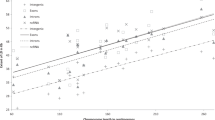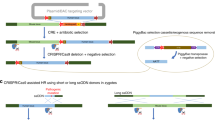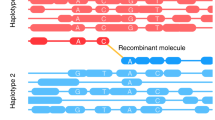Abstract
A physical map of the mouse genome is an essential tool for both positional cloning and genomic sequencing in this key model system for biomedical research. Indeed, the construction of a mouse physical map with markers spaced at an average interval of 300 kb is one of the stated goals of the Human Genome Project1. Here we report the results of a project at the Whitehead Institute/MIT Center for Genome Research to construct such a physical map of the mouse. We built the map by screening sequenced-tagged sites (STSs) against a large-insert yeast artificial chromosome (YAC) library and then integrating the STS-content information with a dense genetic map. The integrated map shows the location of 9,787 loci, providing landmarks with an average spacing of approximately 300 kb and affording YAC coverage of approximately 92% of the mouse genome. We also report the results of a project at the MRC UK Mouse Genome Centre targeted at chromosome X. The project produced a YAC-based map containing 619 loci (with 121 loci in common with the Whitehead map and 498 additional loci), providing especially dense coverage of this sex chromosome. The YAC-based physical map directly facilitates positional cloning of mouse mutations by providing ready access to most of the genome. More generally, use of this map in addition to a newly constructed radiation hybrid (RH) map2 provides a comprehensive framework for mouse genomic studies.
This is a preview of subscription content, access via your institution
Access options
Subscribe to this journal
Receive 12 print issues and online access
$209.00 per year
only $17.42 per issue
Buy this article
- Purchase on Springer Link
- Instant access to full article PDF
Prices may be subject to local taxes which are calculated during checkout
Similar content being viewed by others
References
Collins, F. & Galas D. A new five-year plan for the U.S. Human Genome Project. Science 262, 43– 46 (1993).
Van Etten, W.J. et al. A radiation hybrid map of the mouse genome. Nature Genet. 22, 384–387 ( 1999).
Hudson, T.J. et al. An STS-based map of the human genome. Science 270, 1945–1954 (1995).
Dietrich, W.F. et al. A comprehensive genetic map of the mouse genome. Nature 380, 149–152 ( 1996).
Rhodes, M. et al. A high-resolution microsatellite map of the mouse genome. Genome Res. 8, 531–542 ( 1998).
Haldi, M.L. et al. A comprehensive large-insert yeast artificial chromosome library for physical mapping of the mouse genome. Mamm. Genome 7, 767–769 (1996).
Schuler, G.D. et al. A gene map of the human genome. Science 274, 540–546 (1996).
Deloukas, P. et al. A physical map of 30,000 human genes. Science 282, 744–746 (1998).
Rabbitts, P. et al. Chromosome specific paints from a high resolution flow karyotype of the mouse. Nature Genet. 9, 369– 375 (1995).
Strivens, M.A., Middlehurst, P., Brown, S.D. & Denny, P. HOSEpipe—a WWW-hosted data management and analysis system for STS content mapping projects. Mamm. Genome 8, 467– 471 (1997).
Anand, R. et al. A yeast artificial chromosome contig encompassing the cystic fibrosis locus. Genomics 9, 124– 130 (1991).
Breen, M. et al. Towards high resolution maps of the mouse and human genomes—a facility for ordering markers to 0.1 cM resolution. European Backcross Collaborative Group. Hum. Mol. Genet. 3, 621– 627 (1994).
Denny, P. & Brown, S. Genome mapping. in Mouse Genetics & Transgenics: A Practical Approach (eds Jackson, I. & Abbott, C.) (Oxford University Press, Oxford, 1999).
Soderlund, C. & Dunham, I. SAM: a system for iteratively building marker maps. Comput. Appl. Biosci. 11, 645 –655 (1995).
Evans, E.P. in Genetic Variants and Strains of the Laboratory Mouse (eds Lyon, M.F., Rastan, S. & Brown, S.D.M.) 1446 (Oxford University Press, New York, 1996).
Acknowledgements
We thank D. Henriques, S. Jackson, Y.Y. Lau, S. Greenaway, P. Middlehurst, P. Weston, P. Avner, I. Poras, C. Mundy, B. Gorick, H. Blair, Y. Boyd, J. Crabtree, B. Roe, L. Rogers and J. King for their help in the X chromosome project. T.J.H. is a recipient of a Clinician-Scientist award from the Medical Research Council of Canada. This work was supported in part by grants from the National Institute for Human Genome Research (to E.S.L.), the Medical Research Council, UK, and the Wellcome Trust.
Author information
Authors and Affiliations
Corresponding authors
Rights and permissions
About this article
Cite this article
Nusbaum, C., Slonim, D., Harris, K. et al. A YAC-based physical map of the mouse genome. Nat Genet 22, 388–393 (1999). https://doi.org/10.1038/11967
Received:
Accepted:
Issue Date:
DOI: https://doi.org/10.1038/11967
This article is cited by
-
The Bermuda Triangle: The Pragmatics, Policies, and Principles for Data Sharing in the History of the Human Genome Project
Journal of the History of Biology (2018)
-
The multigene family of fatty acid-binding proteins (FABPs): Function, structure and polymorphism
Journal of Applied Genetics (2006)
-
Initial sequencing and comparative analysis of the mouse genome
Nature (2002)
-
An SSLP marker–anchored BAC framework map of the mouse genome
Nature Genetics (2001)
-
Genetic rat models of hypertension: Relationship to human hypertension
Current Hypertension Reports (2001)



